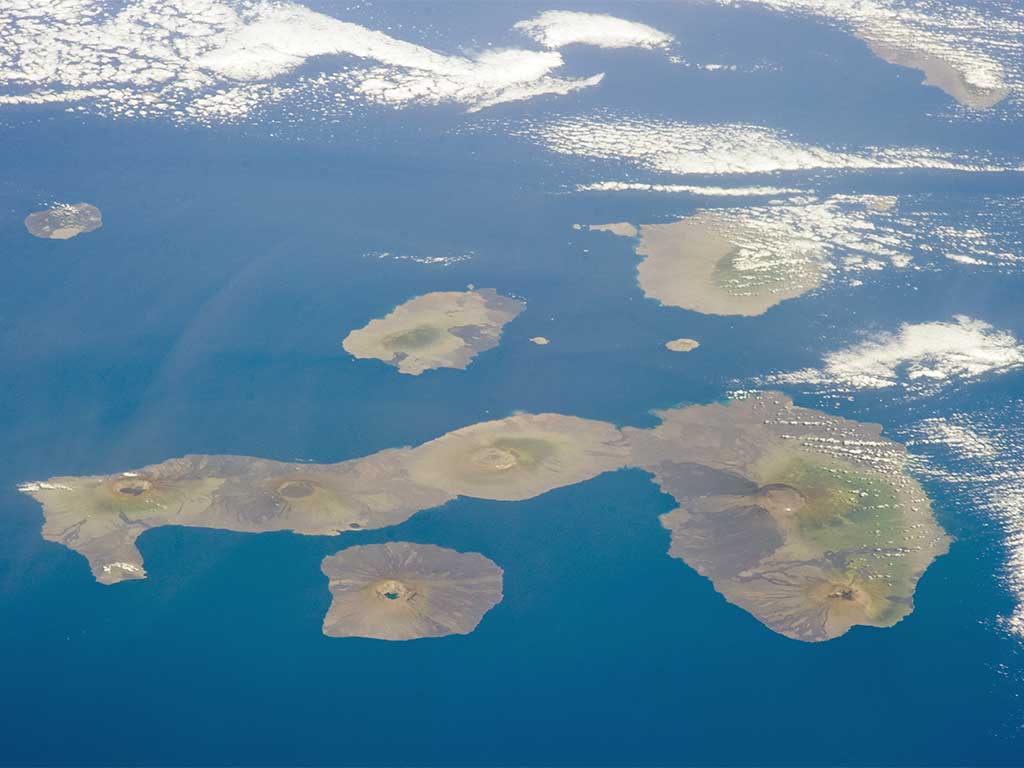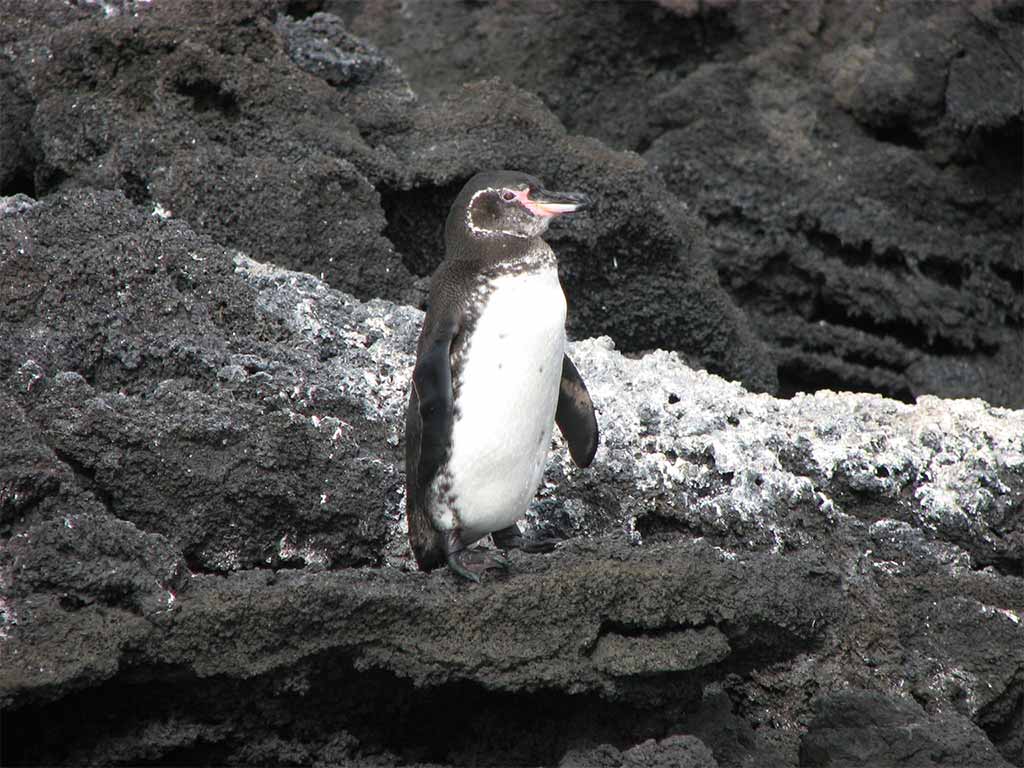History

Galapagos and Beyond: January 2015 Roundup
January 30, 2015
Watch: Undoing the Damage to the Galapagos
This 6-minute video produced by MSNBC explores the impacts of human activity in the Galapagos Islands and ongoing efforts to minimize these impacts. Watch Dr. Linda Cayot, GC's Science Advisor, and personnel from the Galapagos National Park and the Charles Darwin Foundation discuss efforts to restore native ecosystems. The video also investigates the impact of introduced species (of which there are 1,300!), and how to manage a growing tourism industry and increasing human population in Galapagos. Watch it now.
Cargo Ship Runs Aground in the Galapagos Marine Reserve
The past eight months have been hazardous for freighters traveling from the Ecuadorian mainland to Galapagos. On January 26, the M/N Floreana ran aground in the aptly-named "Wreck Bay" off the coast of San Cristóbal Island — the third ship to run aground here since May of 2014. Emergency measures are being taken to ensure safe removal of the ship's cargo and control any fuel spillage, and technicians are beginning to monitor the surrounding ecosystem. Last May, the Galapaface I cargo ship became stranded in the same bay for more than a month. Thankfully, the environmental damage was negligible; we are still awaiting reports from authorities on the status of the M/N Floreana.
See Galapagos Through a Geology Lens
For geologists, the Galapagos Islands are one of the most interesting sites in the world due to their dynamic volcanic nature. From May 27 - June 4 of this year, Brevard College Professor of Geology Dr. Jim Reynolds will lead a Galapagos cruise highlighting the geological processes that formed the Islands. The excursion will include hiking, snorkeling, surface-diving and more to see the many incredible animal species and varying ecosystems. Dr. Reynolds is a member of the Galapagos Conservancy Board of Directors and has led trips to Iceland, Greece, Egypt, and throughout much of Latin America. Read a detailed description of the Galapagos cruise, and visit their Facebook page to stay updated.
Limited-Edition Galapagos T-Shirt by Free World United
Last November, we partnered with cause-based t-shirt company Free World United to raise funds for Galapagos conservation through the sale of unique t-shirts. The campaign was such a success — raising more than twice our original goal of $1,000 — that Free World United has offered to design a "limited edition" Galapagos t-shirt several times a year to complement their selection of Galapagos tees. The first limited design, "The Enchanted Islands," is pictured here. GC will receive $10 from the purchase of this or any other designs on our cause page. Shop the collection and support conservation with a unique t-shirt today.
A Musical Memorial to Lonesome George
Adam Cole of NPR's Skunk Bear — a science micro-blog — wrote and produced a musical tribute in honor of Lonesome George, which features footage of Lonesome George while he was on exhibit at the American Museum of Natural History. Our words can't do it justice…watch and listen for yourself!

Galapagos 2014: Year in Review
December 31, 2014
It's been a great year for conservation in Galapagos, from hand-rearing endangered mangrove finches to repatriating tortoises to their islands of origin. Here are ten of our favorite stories from 2014.
1. The Galapagos Tortoise Webcams Come to Life
With more than 1,000 visitors per month worldwide since their launch in late 2013, the four webcams at the Fausto Llerena Tortoise Center on Santa Cruz have become an increasingly popular way to watch Galapagos tortoises remotely…but it wasn't easy installing the first wildlife webcams in the remote Galapagos Islands! One of our favorite blog posts of 2014 was our interview with Dr. James Gibbs of the State University of New York’s College of Environmental Science and Forestry (SUNY-ESF) and Sean Burnett of Wildlife Intel, who worked closely with the Galapagos National Park to get the cameras set up and running smoothly. From guiding Ethernet cables over trees to shielding the cameras from 400-pound adult tortoises, this was by no means a small feat.
2. Hope for Endangered Mangrove Finches
A landmark program to prevent mangrove finches from going extinct launched in 2014, and with great success. There are only 60-80 mangrove finches left in existence, all on the western coast of Isabela Island — making extinction a sobering possibility. Like other land birds in Galapagos, mangrove finches are threatened by the parasitic fly Philornis downsi, whose larvae feed on the blood of nestlings and cause a high mortality rate. This past spring, researchers hatched and hand-reared 15 mangrove finch chicks in captivity before successfully releasing them back to their natural habitat — effectively keeping the threat of extinction at bay, for now. In the meantime, scientists are studying the Philornis fly in order to find a way to eradicate it permanently.
3. Crisis Averted: Wrecked Cargo Ship Removed from Galapagos Waters
More than two months after running aground off Punta Carola on San Cristóbal Island, the cargo ship Galapaface I was successfully towed to a safe distance outside of the Galapagos Marine Reserve (GMR) and sunk in July of this year. Concerns that the ship posed a contamination risk after running aground in May abounded in the wake of the oil tanker Jessica that wrecked in 2001 — spilling 175,000 gallons of diesel and fuel oil into the ocean. Thankfully, a similar fate was averted with the Galapaface I, as its fuel stores and other contaminants were painstakingly removed shortly after it initially ran aground. Periodic environmental monitoring studies are being conducted to ensure the fragile marine ecosystems surrounding San Cristóbal have not sustained any lasting damage from the wreck.
4. Radiolab Podcast Explores Galapagos Conservation Efforts
In July, popular podcast Radiolab dedicated an episode to some of the biggest conservation successes and challenges in the Galapagos Islands. Produced by WNYC and picked up by nearly 500 NPR stations across the US, Radiolab's podcasts are downloaded by more than 4 million people each month. This special hour-long episode dedicated solely to Galapagos features interviews with GC's Dr. Linda Cayot and many of our grantees and partners in the Islands.
5. Artificial Nests Give Galapagos Penguins a Boost
The Galapagos penguin is the most endangered penguin species in the world, in part due to limited options for nest sites in the Islands. Many nests used in the past either no longer exist or are no longer viable, which inspired Dr. Dee Boersma of the University of Washington and her research team to build 120 artificial nests in 2010. This summer, Dr. Boersma reported that ten of the constructed nests sites contained eggs or chicks, and at least one-quarter of the total active nests have been constructed nests since the project's inception. Dr. Boersma has recommended that the Galapagos National Park create several "Penguin Conservation Zones" in order to provide additional, ongoing protection for these rare birds.
6. Using Drones to Advance Conservation Science
In Galapagos, a research team is using drones — or Unmanned Aerial Vehicles (UAVs) — to photograph entire islands at remarkably high resolution as part of the Galapagos UAV Project. The resulting images make it possible to identify individual plants and animals with virtually no impact on the environment. This past summer, a research team visited the islands of Plazas and Española to take an initial set of baseline images; follow-up images will be taken at the same points in several years in order to monitor changes in the ecosystem over time. In addition to providing a baseline, imagery will be used to survey the number of waved albatross and prickly pear cactus on Española, land iguanas on South Plazas, and eventually giant tortoises on Santa Fe.
7. Lonesome George Exhibit Launches in NYC
In September, the American Museum of Natural History (AMNH) hosted a panel discussion moderated by Chief Conservation Scientist Dr. Eleanor Sterling to launch the opening of the long-awaited exhibit for Lonesome George — the last known tortoise from Pinta Island who died in 2012. A sold-out audience of 300 listened to the remarks of Galapagos National Park Director Dr. Arturo Izurieta, GC President Johannah Barry, GC Science Advisor Dr. Linda Cayot, and Dr. James Gibbs of SUNY-ESF, all of whom knew and had worked with Lonesome George for years prior to his death. Following the iconic tortoise's death in 2012, Galapagos Conservancy took on the complicated task of coordinating and funding the international journey to bring his body to the Museum, where a team of master taxidermists worked for more than a year to preserve him for posterity. Lonesome George will be on exhibit at AMNH in New York until January 2015 before being returned to Ecuador.
8. Conservation Success Story for the Española Tortoise
A study published in PLOS ONE in October reported that efforts to reintroduce the endemic Española giant tortoise have been successful — which is saying a lot, considering that their population had dwindled to only 15 individuals in the 1960s. Those remaining tortoises were captured and bred in captivity, and over the last nearly 40 years, nearly 2,000 have been repatriated to Española Island. According to the study, approximately half of those tortoises are alive today, and many are now breeding naturally on the island. This means that their population is considered stable, making the risk of future extinction low. The study's authors included Dr. James Gibbs of SUNY-ESF, Dr. Linda Cayot of GC, and Giant Tortoise Restoration Initiative (GTRI) Director Wacho Tapia.
9. First-Ever Review of the Galapagos Tortoise Breeding and Rearing Centers
In November, the first annual review of the three Tortoise Breeding and Rearing Centers in Galapagos was completed by GC's Dr. Linda Cayot, Dr. Joe Flanagan of the Houston Zoo, Wacho Tapia of the GTRI, and Galapagos National Park staff. At all three Centers, the team encountered hundreds of healthy tortoises and several with problems, most of which they hope to remedy with improved diet and increased access to sunlight. They also identified several areas for improving the overall program, including data management, infrastructure maintenance, and tortoise feeding — some of which are already being implemented by Park staff. The best practices from each facility will eventually be combined into a care manual to improve the production and vitality of tortoises used to restore Galapagos biodiversity.
10. Comprehensive Population Survey Conducted of Pinzón Island Tortoises
Dr. James Gibbs, Wacho Tapia, and Galapagos National Park rangers conducted a comprehensive population survey of the giant tortoises of Pinzón in December, an island where tortoise numbers had dropped to less than 200 following their depredation by whalers in the 1800s. Rats, introduced to Pinzón in the late 1800s, then preyed on all young hatchling tortoises and effectively prevented any future population growth. Dr. Gibbs and his team now estimate the overall population of tortoises to be more than 500 — a near tripling of the population since the Galapagos National Park was established in 1959, thanks to a successful captive rearing and repatriation program and a rat eradication campaign.
We're happy to end the year on a high note, and look forward to many more exciting developments in 2015. Happy New Year!

Comments